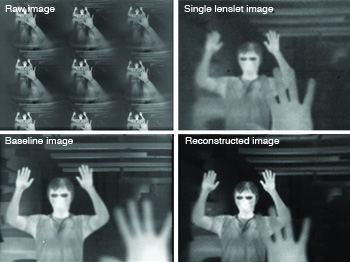Feature
Reinventing the Camera
DARPA’S MONTAGE project took the basic design of the camera back to the drawing board. In doing so, DARPA researchers demonstrated that thin imaging systems based on multichannel and folded path optics can produce high-quality images.
 Images synthesized from the COMP-I Phase II imaging system. The multi-aperture imaging system produces a higher depth of field than a baseline imager due to the shorter effective focal length (4.8 vs. 25 mm). However, this reduction is tempered by the reduced effective pixel size used in the multiaperture system. The imaging near point is reduced from approximately 2 m to 20 cm.
Images synthesized from the COMP-I Phase II imaging system. The multi-aperture imaging system produces a higher depth of field than a baseline imager due to the shorter effective focal length (4.8 vs. 25 mm). However, this reduction is tempered by the reduced effective pixel size used in the multiaperture system. The imaging near point is reduced from approximately 2 m to 20 cm.
In April 2003, we organized a workshop for the Microsystems Technology Office at the Defense Advanced Research Projects Agency (DARPA) called “Camera Ab Initio” (ab initio is Latin for “from the beginning”). The workshop challenged attendees to rethink the architecture of a camera, or, more broadly, an imaging sensor.
…Log in or become a member to view the full text of this article.
This article may be available for purchase via the search at Optica Publishing Group.
Optica Members get the full text of Optics & Photonics News, plus a variety of other member benefits.
